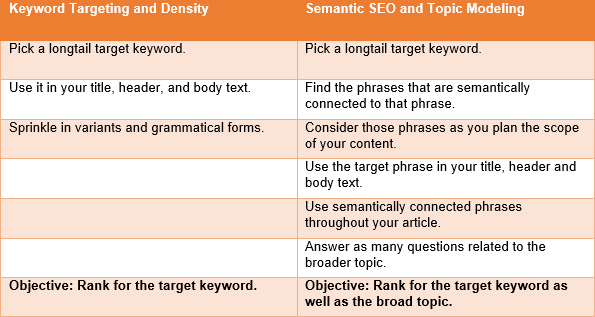How on-page SEO is shifting from keywords to topic modeling in 2018.
Ah, keywords. Those elusive little words that can make or break your entire website, even your business model and strategy. It is scary if you think about how much of your business depends on keywords. These are (potentially) the building blocks of your entire empire.
But keywords aren’t the only factor contributing to your website’s rankings on search engines.
Establishing user intent by discovering topics.
I watched Water for Elephants with my father at the theater when it first came out almost a decade ago. Even though the concept was terrific, it wasn’t a big hit at the box office. So it slowly passed out of memory and recollection, and eventually, my father and I, like other viewers, forgot the name of the movie, the actors in it, the director, and any unique identifiers. I woke up this morning to a phone call from my dad. He wanted me to tell him the name of that movie with the elephants on the train so he could watch it with my mother.
Naturally, I typed “movie about a man and elephants on a train” into Google and lo and behold! The first result to pop up was “Water for Elephants” – and not a page optimized for any of the terms in my search query. Somehow, Google successfully identified my search intent and delivered results based on it.
The big question here is: How did Google manage to interpret my user intent? The simple answer is by discovering topics in the search query.
The fact is that search engines are getting a lot smarter at delivering search results based on not only search queries, but also user intent. They aren’t naïve enough to rank web pages by matching the keywords in searchers’ queries, and to a web page with an optimal number of backlinks, and so on. There is evidence to suggest advanced forms of text mining, textual pattern recognition, and topic modeling are at work here.
Enter topic modeling.
Simply put, text mining, or text data mining, or text analytics, is the process of determining textual patterns within a collection of documents. Topic modeling in turn is the derivation of topics following this process of text mining. For SEOs, topic modeling helps target audiences based on their intent.
Let’s assume you have come into possession of a collection of 10,000 documents on two broad subjects: children’s stories and animal husbandry. Somebody submits a request to your documents about “sheep telling lambs about the danger of wolves.”
I, as a human, can organically establish user intent from this and determine that the person is looking for children’s stories that involve talking sheep who teach their lambs about staying away from wolves. How does a search engine, a nonhuman intelligence that cannot comprehend the meaning of actual words, accomplish this, and not simply deliver a document on “sheep farming” that contains the words “sheep,” “telling,” “lambs,” “danger,” and “wolves”? After all, these are words that can as readily appear in a document about sheep farming as they can in a children’s fable about a sheep, her lamb, and wolves.
I’ll give you a hint. The solution lies in the search word “telling.”
The search engine will analyze the documents to see how often these words appear within proximity of each other to establish topics. The textual pattern that establishes a topic is “sheep telling lambs.” None of the documents about raising farm animals contain any semantic topics, associations, or variants of “telling” between two animal objects. The only ones that do contain the topic of talking animals are the children’s stories. Now that the search engine has filtered out all the documents about animal husbandry, it matches the search words and delivers an Aesop’s fable, The Wolf and the Lamb.
Shifting from keyword targeting to topic targeting.
There are a variety of different mathematical and statistical models that achieve this. Some of these are like Latent Dirichlet Allocation (LDA), term frequency – inverse document frequency, and topic modeling. While this sounds confusing and convoluted, a basic understanding is crucial to deciphering how Google was able to establish that what I sought was the name of a movie based on a vague recollection, and then deliver a search result that answered my question.
What it boils down to is this: topic modeling. Finding a niche and constantly working on building semantic associations between keywords and terms related to them. Keyword density is no longer the only on-page SEO factor, and this is because of its chief drawback: inability to establish user intent.
Unfortunately, there aren’t a whole lot of tools available yet that help SEO specialists work on this. However, Google does help us out in a rather subtle way. Google’s related searches and suggestions are all examples of topic models that Google has learned so far. Any information on “related searches” is going to prove to be a gold mine for SEOs to establish broad niche topics for all their content.
What semantic on-page SEO boils down to.
In a nutshell, semantic SEO is an upgrade from the older algorithms that did not focus on user intent. As a whole, topic targeting ensures enhanced user experience. The customer-centric and user-centric trend is on the rise with no signs of faltering. In order to help you out, this table should enable you to concisely visualize the difference in your approach to planning your semantically strengthened SEO content and niche topics.

Want more insight on SEO? Give us a shout!
